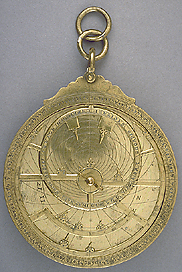
 |
| Catalogue |
 |
 Astrolabe The throne looks very similar to those to be found on early Islamic astrolabes: it is triangular consisting of three lobes on each side. The shackle is inset and suspended from two interlocked rings. The rete also resembles Islamic astrolabes, the unmarked starpointers are in the shape of flames on quadruple lobes. The ecliptic is marked with the usual Latin names of the zodiac, partially abbreviated. Each sign is divided by 6?. The reverse of the rete shows some construction markings. The three plates and the plate in the mater are marked with the circles for the tropics and the equator, almucantars for every 6? and the lines for the unequal hours, numbered 1 to 12. They are laid out and marked (upside down) for the following latitudes (the seven climates): mater 15? (with east and west marked as 'OCCIDE<N>S' and 'ORIENS'), 23?, 30?, 36?, 41?, 45?, and 48?. The back has circular scales as follows: 1) The zodiacal signs marked with the usual Latin names, each sign divided to 30?, numbered by 5? and subdivided to single degrees. 2) The months of the Julian calendar, marked with the Latin names as follows 'IANUARI<US>, FEBRUA<RIUS>, MARCIUS, APRILIS, MADIUS, IVNIVS, IVLIVS, AVGVS<TUS>, SEPTENB<ER>, OCTVB<ER>, NOVENB<ER>, DECENB<ER>'. Each month is divided to the corresponding number of days, numbered by 5 and subdivided to single days. The equinoxes correspond with March 15 and September 171/2. The lower half of the vacant space inside these circles is taken up by a very badly engraved double shadow square and a superimposed horary quadrant on the right which appear to be later markings. The alidade has a drop shaped decoration around the centre hole. The pin head is flower shaped. The wedge is a very stylized horse. The instrument was purchased from the Findlay collection through Sotheby's in 1961 and is described and illustrated in F. A. B. Ward, A Catalogue of European Scientific Instruments in the Department of Medieval and Later Antiquities of the British Museum (London, 1981), pp. 110 and 112, no. 323 (with plate XLIX). Silke Ackermann |



